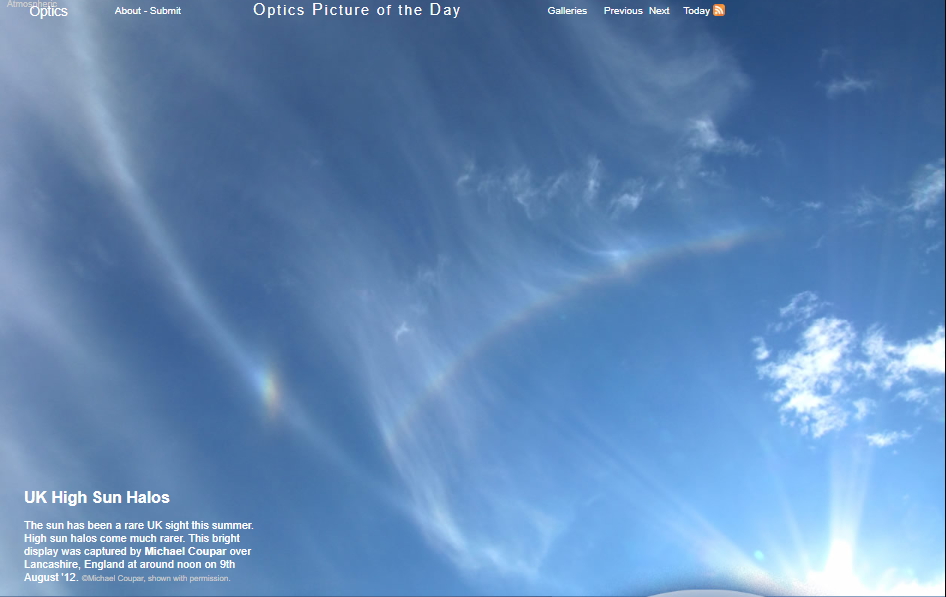OPOD - UK Halos
OPOD - UK Halos: A Rare and Beautiful Atmospheric Phenomenon
The enchanting world of atmospheric optics never ceases to amaze us. Amidst the rarity of the summer sun in the United Kingdom, a remarkable display of high sun halos graced the skies, leaving observers in awe. On the 9th of August '12, Michael Coupar captured this extraordinary spectacle over Lancashire, England. The sun, positioned 49° high in the cirrus-streaked sky, created a mesmerizing show that was truly a sight to behold.
Exploring the High Sun Halos
At the heart of this celestial exhibition lies a bright white parhelic circle, formed by the interaction of plate and column crystals. This circle passes through the sun, extending an astonishing 120° around the zenith. The parhelic circle, with its ethereal glow, serves as a gateway to a world of atmospheric wonders.
The Enigmatic Circumscribed Halo
As our gaze extends beyond the parhelic circle, we are greeted by a colorful arc curving around the sun. This captivating arc is none other than a fragment of a circumscribed halo. Created by horizontal column crystals, this halo is the high sun counterpart of the upper and lower tangent arcs commonly observed at lower sun angles.
Unveiling the 22° Halo Fragment
Within the boundaries of the circumscribed halo lies a subtle yet enchanting phenomenon - a fragment of a 22° halo. This delicate halo fragment adds another layer of intrigue to the already mesmerizing display. Its presence within the larger halo structure enhances the complexity and beauty of this atmospheric masterpiece.
The Prismatic Patch: A Sundog in the Skies
Gazing towards the right of the image, we are met with an intriguing sight - a slanting prismatic patch adorning the parhelic circle. This patch is none other than a sundog, a phenomenon caused by the refraction of sunlight through plate crystals. The high sun angle, coupled with the presence of plate crystals, has shifted the sundog away from its typical position at a 22° distance from the sun.
A Glimpse into What Could Have Been
To truly appreciate the rarity and beauty of the Lancashire display, we turn to a HaloSim ray tracing representation. This simulation showcases what a more complete cirrus sky coverage might have revealed. However, it is often the incompleteness and asymmetry of nature that gives rise to its most captivating and breathtaking moments. The Lancashire display, with its partial view of the atmospheric phenomena, offered a glimpse into the grandeur and complexity of the natural world.
Conclusion: A Moment of Atmospheric Splendor
The high sun halos witnessed over Lancashire, England on that fateful day in August '12 were a testament to the captivating beauty of atmospheric optics. From the ethereal parhelic circle to the enigmatic circumscribed halo and delicate 22° halo fragment, each element contributed to an awe-inspiring display. The presence of a sundog, shifted from its usual position, added an extra touch of intrigue. Although a more complete cirrus sky coverage might have revealed even more wonders, it is in the imperfections and asymmetry that true beauty often lies. The Lancashire display will forever remain etched in our memories as a moment of atmospheric splendor.

UK High Sun Halos
The sun has been a rare UK sight this summer. High sun halos come much rarer. This bright display was captured by Michael Coupar over Lancashire, England at around noon on 9th August '12. ©Michael Coupar, shown with permission.

The sun in the cirrus streaked sky was 49° high.
A bright white parhelic circle from plate and column crystals passed through the sun and extended some 120° around the zenith.
The coloured arc curving around the sun is a fragment of a circumscribed halo. Horizontal column crystals make the halo which is the high sun version of upper and lower tangent arcs.
Showing weakly inside the circumscribed halo is a 22° halo fragment.
The slanting prismatic patch on the parhelic circle is a sundog. The high sun and consequent skew angles through plate crystals has shifted it well away from the 22° sun distance oft quoted for sundogs.
At right a HaloSim ray tracing shows what a more complete cirrus sky coverage might have shown. But beauty often comes from incompleteness and asymmetry. The Lancashire display was of enough rarity and beauty.
Note: this article has been automatically converted from the old site and may not appear as intended. You can find the original article here.
Reference Atmospheric Optics
If you use any of the definitions, information, or data presented on Atmospheric Optics, please copy the link or reference below to properly credit us as the reference source. Thank you!
-
<a href="https://atoptics.co.uk/blog/opod-uk-halos/">OPOD - UK Halos</a>
-
"OPOD - UK Halos". Atmospheric Optics. Accessed on November 26, 2024. https://atoptics.co.uk/blog/opod-uk-halos/.
-
"OPOD - UK Halos". Atmospheric Optics, https://atoptics.co.uk/blog/opod-uk-halos/. Accessed 26 November, 2024
-
OPOD - UK Halos. Atmospheric Optics. Retrieved from https://atoptics.co.uk/blog/opod-uk-halos/.